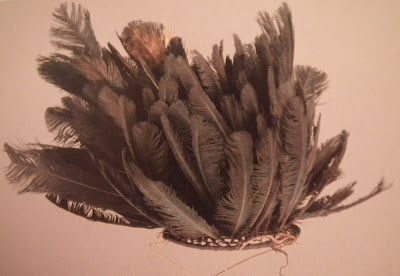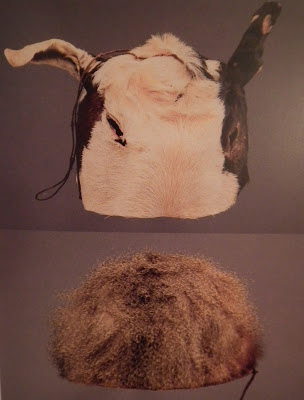The images and quotes below are from my newly acquired copy of 'Royal Museum for Central Africa - Collections of the RMCA. Headdresses'. (Thanks again Katie)
As the 11th biggest country in the world, it is no surprise that the range of traditional headwear in the the Democratic Republic of the Congo is as vast as the place itself. As with other cultures, headdresses in the DRC are symbols of power and an accumulation of wealth with materials such as cowries, which arrived from colonial exchange, being displayed on the person to indicate their value. Materials used varies incredibly from feathers to hides as well as bone, teeth and hair, presented as tribute to chiefs and kings of various hierarchies. This book doesn't merely show examples of DR Congolese headdresses but gives details of their significance to the wearer, as well as specific back stories where available. These headpieces are then grouped by material, ethnic group/religion, region and context.
Lega - The Bwami society
The eastern DR Congolese Lega people often belonged to the political, religious and social structure known as Bwami, the initiation ceremony of which was 'viewed as an organised form of resistance by certain colonial administrators.' The basic materials worn by entrance level initiates of Bwami consisted of fibres, cowries and leather but these caps were worn underneath more complex headdresses as the candidate progresses through the initiation. The spectacle of the final rank in Bwami society fascinates me, as the 'Kindi' (highest rank) are the only members permitted to wear elephant tail, hornbill beak and possibly eland hide. Infact at this level of Bwami, it's possible that personal taste defined the selection of adornment.
It appears to me that the more complete and grand the animal part used, the closer the wearer is to the force of nature and therefore to power. This book confirms this as well as delving into more specific symbolism for example the elephant tail which being 'a herd animal, symbolised solidarity among Bwami members.'
Feathers
Unconfirmed origin but almost certainly from the DRC, red jungle fowl feathers used.
This headdress was worn for Likita dances and ceremonies. The feathers are fishing owl combined with rhinoceros beetle thorax
Giant blue turaco and hornbill feathers worn by men of the Mungongi society amongst the Yaka and Pende peoples
Luba grey parrot/grey woodpigeon headdress. This piece is particularly interesting due to the sheer volume of parrot feathers for a start, over 500, which would have used the tail feathers of around 50 birds. Though frequently used, Luba headdresses like these are rarely photographed. The unobtainability of the materials used benefited the courts of the Luba Kingdomthrough use of ritual and sway over conquered regions and trading partners.
Luba grey parrot/assorted goose and duck feathers (left), Mangbetu headdress with various guinea fowl and eagle owl feathers
Animal hide
Goat hide Ngundu headdress and silver monkey Egbaka headdress
Leopard scalp headdress, possibly from Bwami society
Pangolin headdress, DRC
Though I have posted some of my favourite animal based headdresses above, 'Royal Museum for Central Africa - Collections of the RMCA. Headdresses' contains many more. Details of the collectors are provided alongside the controversy of their collector or looter status, combined with information of the 'Scramble for African Art' to give readers another dimension to the collection. Not only does the book touch on animal symbolism it also delves into anti-colonial headdresses that contrast with western influenced designs. This publication is ideal for anyone interested in anthropology, hats/headdresses or many aspects of African culture.























No comments:
Post a Comment